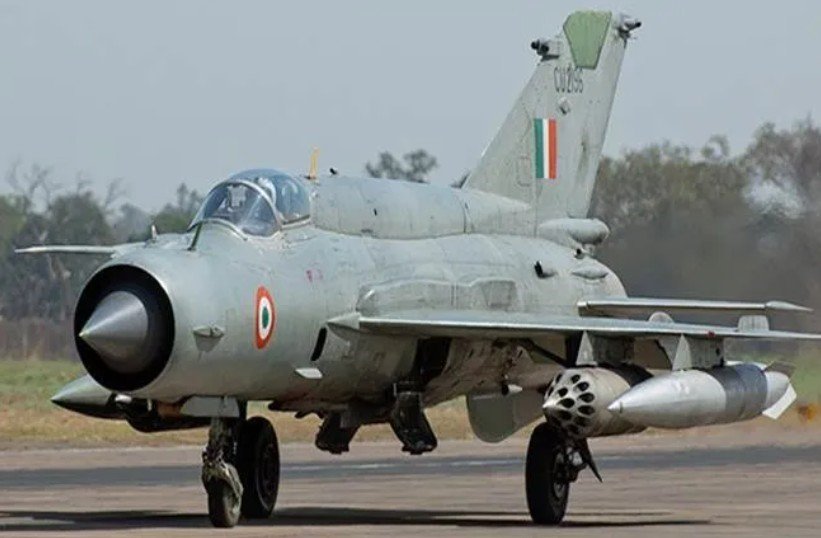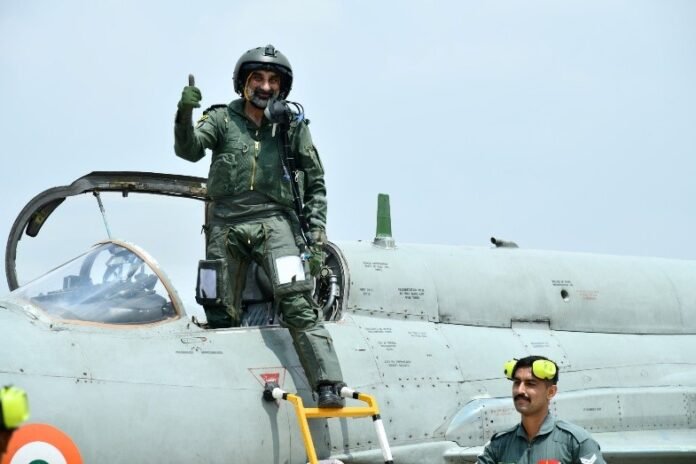As the pair of two MiG 21 Bison of Panthers Squadron led by Squadron Leader Priya Sharma in the lead fighter jet and Air Chief Marshal Amar Preet Singh in the second aircraft lined-up at the beginning of the Runway 02 of Nal Airbase, early morning on August 22, 2025 and Air Traffic Control somewhere in Rajasthan cleared them for take-off, the history was in making.
These were the last farewell sorties for the old faithful hawks of the Indian Air Force, who were the frontline supersonic fighters since the last 62 years or so. The two MiG 21 rolled on the tarmac with full thrust of single Tumansky R 25-300 of 69 kN turbo jet engine and took off gracefully into the blue horizon. After 45 minutes of the sortie over Thar desert, the fighters landed safely back home.
As the canopy was lifted and Air Chief Marshal de-boarded, he waved at the Station Commander and kissed the fuselage of the war machine. Later, the ACM addressed the Air warriors of the station and said “MiG 21 was an amazing fighter aircraft, agile and manoeuvrable and it will be missed by all who flew it.”
It was a wonderful supersonic fighter interceptor and it had a long tenure with the IAF and participated in the major wars of 1965, 1971, 1999 and Op Balakot in 2019 with Pakistan.
MiG 21 were inducted in IAF in 1963. Due to the limited numbers and pilots being not trained on the new machine, it played a very limited defensive role in the Indo Pak War of 1965 but still the Indian pilots liked the new supersonic aircraft and gained experience and confidence in modern supersonic fighter of the 60s
ACM said that although, he had flown all old and new generation fighters like Mirage 2000, SU 30 MKI, Rafales but handling a MIG 21 required expertise of a different calibre. The war bird will take care of you if you take care of it. He saluted the old flying bird before departing, with moist eyes.
The final farewell parade of MiG will be held at Chandigarh Air Base. Presently, IAF has two squadrons of MIG 21 Bisons, which will be grounded forever on September 26, 2025.
MiG 21 is a Russian origin Supersonic Jet Fighter and interceptor aircraft designed by Mikoyan-Gurevich Design bureau of the erstwhile Soviet Union in early 1950. The first test flight was conducted successfully on June16 1955. It was finally inducted into service of the Soviet Airforce in 1959. The total number of the aircraft, produced till date is 11,496.
USSR assisted India in establishing a production facility at Ojhar near Nasik in Maharashtra under license to Hindustan Aeronautics Limited (HAL). India acquired 870 Mig 21s, out of which HAL manufactured about 600 plus aircrafts.
HAL is the largest producer of Russian aircrafts outside Russia. It even has maintenance and engine overhauling facility. MIG 21 was in service in more than 60 countries in the world.
The countries are still using Mig 21 are Angola, Cuba, Mali, Mozambique, North Korea, Sudan, Yemen, Syria but most of them are now under obsolesce.
The former operators were Afghanistan, Algeria, Bangladesh, Belarus, Bulgaria, Burkina Faso, Cambodia, China, Republic of Congo. Croatia, Czechoslovakia, East Germany, Egypt, Eritrea, Ethiopia, Finland, Guinea-Bissau, Germany, Georgia, Hungary, Indonesia, Iran, Iraq, Kyrgyzstan, Laos, Malagasy, Mongolia, Namibia, Nigeria, Poland, Russia, Serbia, Somalia, Tanzania, Turkmenistan, Uganda, Ukraine, Yugoslavia, Zaire, and Zambia.
MiG 21 played a vital role in Bangladesh Liberation War in 1971. Before the war, about 5 Squadrons of the IAF had converted to MiG 21 and were ready to face the adversary. India had to be prepared for three front War in East, West, and North
After the Chinese aggression, India wanted to upgrade the Indian Air Force as Pakistan was gifted modern fighter jets like Starfighters and Sabre jets as it joined CENTO and SEATO.
IAF had Hawker Hunters, Mystere IV, Canberra and Foland Gnats. All were old vintage sub-sonic aircrafts. India was finally offered MiG 21 by Soviet Union at Rupee-Rouble payment and offered to establish a manufacturing plant in collaboration with Hindustan Aeronautics.
MiG 21 were inducted in IAF in 1963. Due to the limited numbers and pilots being not trained on the new machine, it played a very limited defensive role in the Indo Pak War of 1965 but still the Indian pilots liked the new supersonic aircraft and gained experience and confidence in modern supersonic fighter of the 60s.

India initially imported 205 old variants of MiG 21 FL (Type 77) fitted with 23mm cannon and 57 mm rockets. Later, in 1970s, India manufactured or assembled upgraded version of 85 MiG 21M (Type 88) at HAL, Nasik Division. These were fitted with K-13 air to air missiles (AAM).
In 1990, HAL established the assembly line for a new variant of the MiG 21 Bi, fitted with active homing long range R-55 AAMs and better avionics. In 2010, HAL upgraded to its latest variant, named MIG 21(UPG) Bison fitted with R60 AAM and Israeli radars.
MiG 21 was a cone nosed, delta wing configuration capable of flying at the maximum speed of 2200km/h (Mach 2 Plus), double the speed of sound. It was fitted with single engine Tumansky R25-300 power plant capable of achieving 69.6 kN thrust. It had a cruising range of 660 kms, which could be enhanced with drop tanks to 790 kms. It could fly up to 57,400 feet (17,500 m). It required 850 m to take off and 550 m length of runway. Its landing speed was very high; therefore, brake parachutes or air brakes were required. The armaments fitted were one 23 mm Gsh 23 L autocannon. It could carry AAMs (K13, R 55 or R 60)/4 X UB Rocket pods with 16 rockets/2×500 kg bombs.
MiG 21 participated in Kargil War of 1999, also. They carried out heavy bombing on Pak intruders under Op Safed Sagar, but one MiG 21 was shot-down by a Stinger missile in Batalik Sector, while looking for his wingman, who had crashed and was taken prisoner
MiG 21 played a vital role in Bangladesh Liberation War in 1971. Before the war, about 5 Squadrons of the IAF had converted to MiG 21 and were ready to face the adversary. India had to be prepared for three front War in East, West, and North.
The induction of MiG 21 boosted the morale of the armed forces. It provided air superiority within 48 hours of the war, which was declared on December 3, 1971. During Bangladesh War, MiG 21 Squadrons grounded a Sabre Squadron at Dacca by destroying the runway and claimed four F104 Star Fighters, two F-6 Shenyang, two Sabre F 86 and one C-130 Hercules. MiG 21 was a clear winner in the1971 War. India procured about 870 MiGs 21 till 2023.
MiG 21 participated in Kargil War of 1999, also. They carried out heavy bombing on Pak intruders under Op Safed Sagar, but one MiG 21 was shot-down by a Stinger missile in Batalik Sector, while looking for his wingman, who had crashed and was taken prisoner.
Squadron Leader Ajay Ahuja was captured and killed by the Pak Army, he was awarded Vir Chakra posthumously. On August 10, 1999, two MiG 21s intercepted one Pakistani Breguet 1150 Atlantic maritime patrol aircraft in Rann of Kutch and shot-it down with AAM R-60 Killing all 16 soldiers on board.
As a retaliation to the Pulwama terrorist attack of February 14, 2019, Indian Air Force carried out surgical airstrike at a Jaish training camp at Balakot in Khyber Pakhtunkhwa and launch pads at Chikoti and Muzaffarabad in PoK in the wee hours of February 26, 2019 and killed about 100 terrorists. MiG 21s were also deployed on diversionary roles.
The question might be asked as to why it took so long to declare MiG 21, as obsolete despite its vintage and high accident rates. India from 1980 to 2000 was a developing economy with limited foreign exchange reserves, facing natural calamities, additionally
On February 27, 2019, a taskforce of 12 Pak fighters retaliated under Op Swift Retort and crossed the LoC in Poonch Naushera sector. IAF was on op readiness platform. Sukhoi 30 Mk I and Mirage 2000 blocked them. Pak Fighters immediately turned back discharging bombs in jungles. Wing Cdr Abhinandan Vardharajan was also in the general area on Combat Air Patrol. He saw a F16 escaping back to the PoK. He chased it and locked his AAM R- 60 and shot it.
He never realised that he had entered the Pak Air space. Meanwhile, another F16 engaged him with a sidewinder AAM. He ejected and landed in PoK. He was made a PoW, but was released and returned to India on March 1, 2019. He was awarded with MVC and it was also an honour to his MiG 21. Two IAF squadrons were kept on High Alert in Op Sindoor till as late as May 2025.
The question might be asked as to why it took so long to declare MiG 21, as obsolete despite its vintage and high accident rates. India from 1980 to 2000 was a developing economy with limited foreign exchange reserves, facing natural calamities, additionally.

USA was not ready to give frontline fighters aircraft like Star Fighters F104 or F16/ F18, to India. Russians provided us with MiG 21 at one-third the cost of a F16. Moreover, they assured of 100% transfer of technology and collaborated with HAL to establish a manufacturing or an assembly plant at Ojhar, Nasik in India.
The cause of high accident rates was a combination of both human and technical errors. India had no supersonic aircrafts till the arrival of MiG 21 in 1964, Indian pilots were trained on old vintage crafts like the HT2, Kiran and Iskara sub-sonic jets, with old avionics and navigational instruments.
Let us bid farewell to the old faithful MiG 21 and thank them for their 60-years long yeoman services to India and welcome our own Tejas Light combat and AMCA aircrafts, which will replace the MiG 21
MiG 21 had a very high landing and take-off speed and sensitive controls and supersonic speed. A sudden shift from first generation to a third-generation aircraft caused accidents. IAF lost large number of MiG 21 aircrafts in crashes and it is really sad to note that many young talented pilots lost their lives, during the last 62 years of the craft’s long service to the nation.
The accident rates were considerably reduced once IAF acquired Advanced Jet Trainers Hawks from United Kingdom in 1990s. The later versions of MiG Series of aircrafts operated by IAF i.e. MiG 23, MiG 25, and MiG 27 have retired from service longtime back but the MiG 21s still protected the Indian frontiers till 2025 along with 4/5 Generation of modern fighters like MiG 29, SU 30MkI and now Rafales.
Let us bid farewell to the old faithful MiG 21 and thank them for their 60-years long yeoman services to India and welcome our own Tejas Light combat and AMCA aircrafts, which will replace the MiG 21.
-The writer is an Indian Army veteran and a defence analyst. He has keen interest in Geo-strategic affairs and writes regularly on internal and external affairs issues related to India and neighbours. The views expressed are personal and do not necessarily reflect the views of Raksha Anirveda






